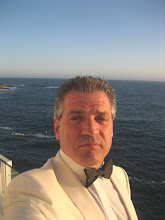In the city of of Reims (pronounced Rance), the former Roman capital of ancient Gaul, we are enthralled by a vibrant town steeped in history. No place is more emblematic of this than the Reims Cathedral, where every French King since Charlemagne was crowned, most notably the Dauphin who was crowned Louis VI in the presence of Joan of Arc. Like so many cathedrals of Europe it is draped in scaffolding in one part....the constant refurbishing and cleaning that is as perpetual as the orbit of the Earth around the sun. But its impact is immeasurable...and as I am fond of saying, if we are so impressed with it, imagine what the peasant of the 14th century thought. Imagine indeed. Inside, in addition to a knave dedicated to St Joan, there is a prominent Marc Chagall stained glass window even more impressive than the one in Vence. Though this massive cathedral was relegated to being used as a barn by the French Revolution (which had a distain for the church due to their revolutionary and jaundiced view of the aristocracy), decimated during World War I, rebuilt by funds from the Rcokefeller, Carnegie and Ford Foundations, occupied during WWII and now a vestige for the ages, Reims Cathedral is awe inspiring for the knowledge of all that has transpired in its vaulted ceilings through the centuries.
We stayed at the Hotel de la Paix in the center of town, perfectly located off the main square. A comfortable hotel with a pool and steam room (which was well utilized by certain guests with a flair for the dramatic) it was a fine jumping off point for our adventures through the champagne region. Dinner one night was at the eclectic Le Cafe du Palais, across from the Palace of Justice and the architecturally imposing concert hall. A family affair since 1930, Cafe du Palais specializes in hearty peasant fare, regional dishes and an authentic local bistro feel you can't fake, and local chesses you can't resist.
While in Reims we visited the cellers of Vueve Cliquot (literally the Widow Cliquot, a reference to the Grand Dame of the business who inherited it as a young woman when her husband died in the late 1790s). As remarkable as the champagne (known worldwide and immortalized in the film Casablanca - Inspector Rennault: "I'll have a bottle of Vueve Cliquot 1927." (and then turning to Major Strasser) "Its a good French wine!") are the cellars, into which we descend 150 feet into the ground to explore these amazing caverns carved out of pure chalk by the Romans over 2000 years ago. There are 11 miles of them under Vueve Cliquot alone....11 miles, with hundreds of thousands of cases of champagne aging in them for 3 to 9 years, and a fleet of speeding forklifts plying an underground highway to move them around. It is astonishing, ghostly and beautiful. The Devil Dog was moved at the sight of all that champagne, and the realization that these had also served as bomb shelters during two world wars. Ascending up the exit stairs and emerging through a hidden chamber into the tasting room, we ruminated on the regal history of the Widow Cliquot (and all that she has wrought through two centuries) over several vintage bottles of her namesake, capped off with a glass of her premier Grand Dame release.
Tuesday, September 23, 2008
Subscribe to:
Post Comments (Atom)

No comments:
Post a Comment